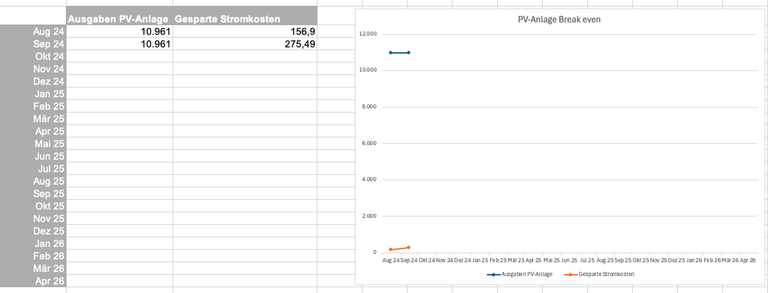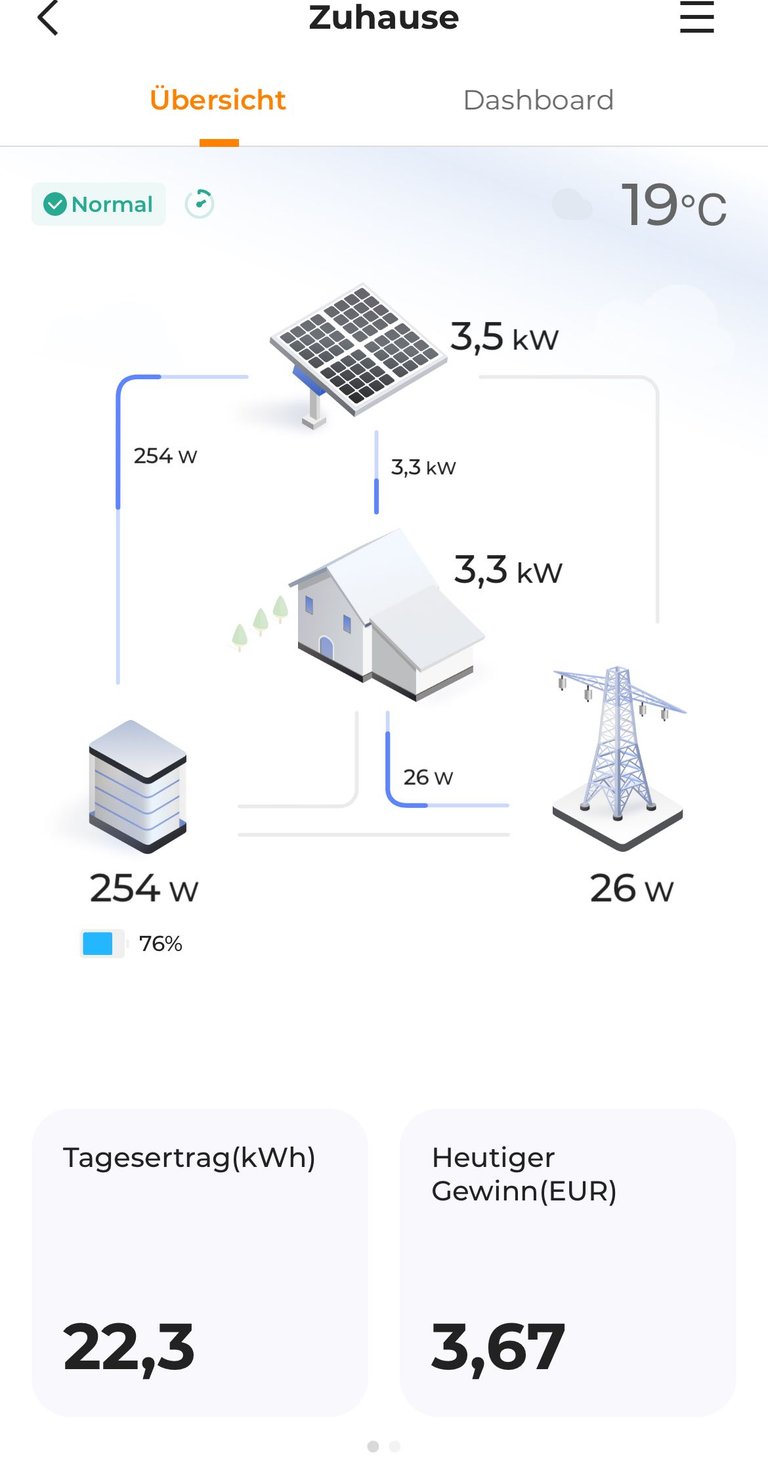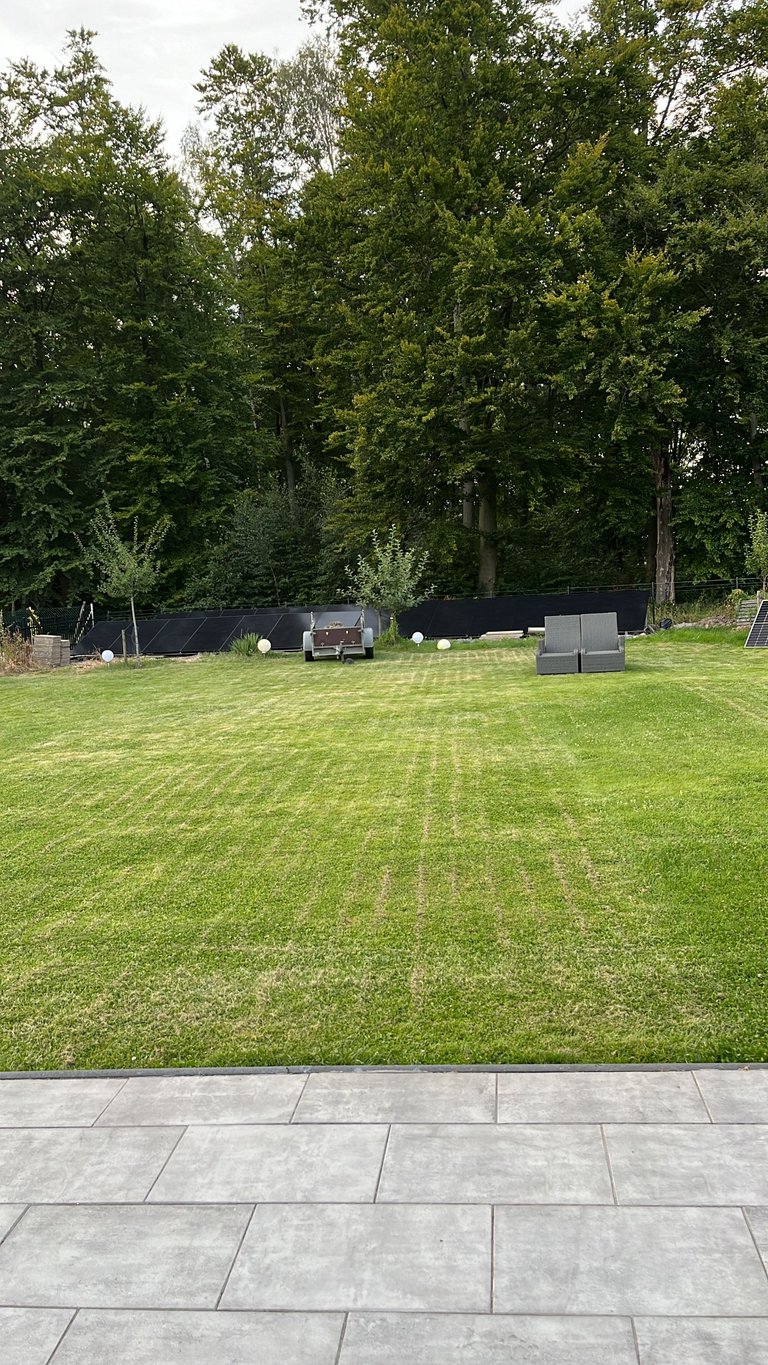Hallo liebe Dach Community,
nach über 2 Monaten Bauzeit ist am 12. August meine DIY PV-Anlage ans Netz gegangen. Anders als die meisten kleineren PV-Anlagen ist diese nicht auf einem Dach montiert, sondern am Grundstücksende an meinem Zaun aufgestellt.
Dort hat die Anlage eine sehr gute Südausrichtung und wird nur für kurze Zeit durch zwei Bäume verschattet. Beide Bäume werde ich im Oktober umpflanzen, damit die Anlage im nächsten Jahr die volle Leistung erreichen kann.
In diesem Beitrag werde ich zum ersten Mal Kosten und Ersparnis gegenüberstellen.
Viel Spaß beim Lesen!
Kostenübersicht und Wirtschaftlichkeitsrechnung
Die Kosten der Anlage verteilen sich auf folgende Punkte:
- Miete Bagger Fundament 213€
- Miete Bagger Rohre verlegen 237€
- Kabel und Stecker 350€
- PV-Anlage, Wechselrichter und Speicher 8.961€
- Anmeldung und Anschluss 600€
- KG Rohre 200€
- PV Halterungen 400€
Die Anlage hat 20 Platten Full Black, je 410 Watt, der Wechselrichter hat eine Leistung von 8 KW sowie eine Notstromfunktion und der Speicher hat eine Größe von 9,6 KW.
Aktuell zahle ich einen Strompreis von 29,5 Cent je KwH. Das bedeutet die Anlage muss insgesamt 37.155 KwH erzeugen, welche ich auch verbrauchen muss, damit ich die Kosten wieder drin habe.
Break-Even Übersicht

Wie Ihr sehen könnt, habe ich in den ersten fünf Wochen gut 275€ an Stromkosten eingespart. Persönlich finde ich das Ergebnis extrem gut, da es für mich bedeutet, dass ich in dieser Zeit fast 100 % meiner Stromkosten über die PV-Anlage abdecken konnte. Dabei sind sowohl das Laden unserer E-Autos als auch der Betrieb des Whirlpools mit inbegriffen.
Lediglich unser Kryptominer hat ab und an Strom aus dem Netz gezogen.
Als ich mit der Planung der PV-Anlage begonnen habe, war mein Fokus darauf ausgelegt, eine möglichst gute Kosten-/Nutzenrechnung aufzustellen. Ziel der PV-Anlage ist es, dass sich diese in fünf Jahren vollständig amortisiert hat. Um dieses Ziel zu erreichen, muss ich jedes Jahr über 2.000€ Strom mit der Anlage einsparen.
Sind meine Einsparziele realistisch?
Grundsätzlich muss man sagen, dass solch hohe Einsparziele nicht für jeden umsetzbar sind und man sich beim Planen eines solchen Projekts nicht selber belügen sollte.
Gerade wenn man sich zu tief in Excel-Kalkulationen verliert, kann dies schnell passieren.
Warum ich trotzdem von dieser hohen Ersparnis überzeugt bin, lässt sich relativ platt ausdrücken: Wir haben einen überdurchschnittlich hohen Stromverbrauch. Zurückzuführen ist dieser vor allem auf unsere E-Autos. Diese stellen mit ihrer zusätzlichen Stromspeicherfunktion einen wichtigen Bestandteil der Kosten-/Nutzenrechnung dar. Was meine ich damit?
Im August hat die PV-Anlage an vielen Tagen 30 bis 50 KwH erzeugt. In normalen Haushalten wäre nach spätestens 2 Stunden der hauseigene Speicher voll und der restliche Strom würde für wenige Cent in das Stromnetz eingespeist werden.
Unsere E-Autos haben zusammen eine Ladekapazität von 130 KW. Dazu kommt nochmal der Hausspeicher mit 9,6 KW. Wir können also insgesamt fast 140 KW unseres produzierten Stroms speichern und selbst nutzen.
Dadurch ist fast immer sichergestellt, dass wir keinen Strom in das Stromnetz einspeisen, sondern die eben genannten hohe Einsparung erreichen.
Eine Einspeisung von überschüssigen Strom ins Netz erfolgt also fast nur in Ausnahmefällen, wenn unsere Autos kaum bis gar nicht bewegt werden und somit auch kein Stromverbrauch durch diese erfolgt. Dies ist zum Beispiel bei Urlauben der Fall.

An diesem Screenshot aus der App der PV-Anlage lässt sich das beschriebene Szenario gut erkennen: Sobald unser Hausakku über 60 % geladen ist, wird automatisch eines unserer Autos geladen. Je nach Stromproduktion wird dabei die Ladegeschwindigkeit zwischen 1 KwH und 8 KwH eingestellt.
Ausblick
Ich werde die Break-Even Excel konstant fortführen. Falls neue Kosten durch Wartung oder Verschleiß auftreten, werde ich diese natürlich auch entsprechend eintragen. Aber keine Angst ich werde Euch nicht mit einem monatlichen Update nerven.
Das nächste Update zu der PV-Anlage gibt es erst, wenn das Jahr beendet ist und danach immer in halbjährlichen Abständen. Wichtig ist mir Euch zu zeigen, wie viel Geld man durch gut geplante DIY Projekte einsparen kann.
Bis zum nächsten Mal
Euer Ogfox
English
Hello dear roof community,
After more than 2 months of construction, my DIY PV system was connected to the grid on August 12th. Unlike most smaller PV systems, this one is not mounted on a roof, but installed at the end of the property next to my fence.
The system has a very good southern exposure and is only shaded for a short time by two trees. I will be replanting both trees in October so that the system can achieve its full output next year.
In this article I will compare costs and savings for the first time.
Enjoy reading!
Cost overview and profitability calculation
The costs of the system break down as follows:
- Rent excavator foundation 213€
- Hire of excavator to lay pipes 237€
- Cable and plug 350€
- PV system, inverter and storage 8.961€
- Registration and connection 600€
- KG pipes 200€
- PV brackets 400€
The system has 20 Full Black panels, each with 410 watts, the inverter has an output of 8 KW and an emergency power function, and the storage system has a capacity of 9.6 KW.
I currently pay an electricity price of 29.5 cents per KwH. This means that the system has to generate a total of 37,155 KwH, which I also have to consume in order to recoup the costs.
Break-even overview

As you can see, I saved a good €275 in electricity costs in the first five weeks. Personally, I think the result is extremely good, as it means that I was able to cover almost 100% of my electricity costs with the PV system during this time. This includes charging our electric cars and running the hot tub.
Only our cryptominer drew electricity from the grid from time to time.
When I started planning the PV system, my focus was on achieving the best possible cost/benefit calculation. The aim of the PV system is for it to be fully amortized in five years. To achieve this goal, I need to save over €2,000 in electricity every year with the system.
Are my savings targets realistic?
Basically, it has to be said that such high savings targets are not feasible for everyone and you shouldn't lie to yourself when planning a project like this.
This can easily happen, especially if you get too lost in Excel calculations.
Why I am nevertheless convinced of these high savings can be expressed relatively simply: We have above-average electricity consumption. This is mainly due to our electric cars. With their additional electricity storage function, they are an important part of the cost/benefit calculation. What do I mean by that?
In August, the PV system generated 30 to 50 KwH on many days. In normal households, the in-house storage system would be full after 2 hours at the latest and the remaining electricity would be fed into the grid for a few cents.
Our electric cars have a combined charging capacity of 130 KW. Then there's the home storage unit with 9.6 KW. This means we can store a total of almost 140 KW of the electricity we produce and use it ourselves.
This almost always ensures that we do not feed any electricity into the grid, but achieve the high savings just mentioned.
This means that surplus electricity is almost only fed into the grid in exceptional cases, when our cars are hardly moved or not moved at all and therefore do not consume any electricity. This is the case during vacations, for example.
IMG_6045.jpg]( )
)
This screenshot from the PV system app clearly shows the scenario described: As soon as our home battery is charged to over 60%, one of our cars is automatically charged. The charging speed is set between 1 KwH and 8 KwH, depending on the electricity production.
Outlook
I will continue to use the Break-Even Excel constantly. If new costs arise due to maintenance or wear and tear, I will of course enter these accordingly. But don't worry, I won't annoy you with a monthly update.
The next update on the PV system will only be when the year is over and then every six months. It's important to me to show you how much money you can save with well-planned DIY projects.
See you next time
Your Ogfox

Wieviel macht denn hier der Speicher aus? Meiner Meinung nach ist es immer noch die teuerste Position im Hinblick zur Wirtschaftlichkeit.